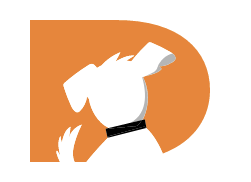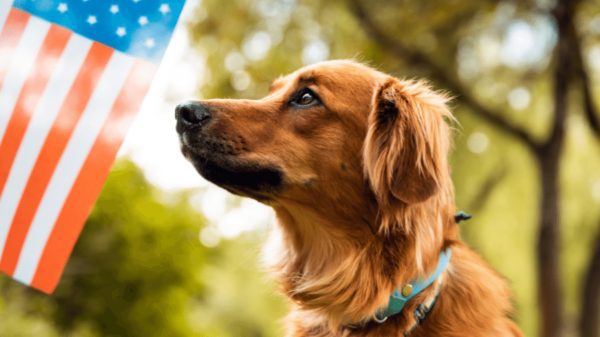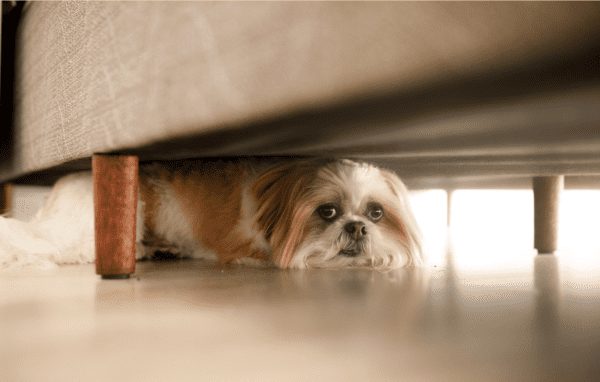5 min read
Ensure your dog is safe and calm during the Fourth of July
Guest Blogger : Jun 24, 2021 10:54:40 AM

Fun on the Fourth
I’ve always loved the 4th of July. One of my favorite ways to enjoy fireworks is paddling in a marina, watching the beautiful bright sky from the quiet peace of the ocean, away from the touristy crowds.
My other favorite way to enjoy fireworks is… can you believe… with my dogs?! Preston & Delilah equate the boom and flash of fireworks to equal meat raining down from the sky! I’ve done everything to prepare my dogs for fireworks and make it a positive experience (with the help of yummy barbecue). Now my dogs are in the very rare percent of animals who not only don’t mind the fireworks, but actually enjoy watching them with me. This process took hours and hours individually training each dog, from day one. Early socialization with puppies that includes desensitization to sounds is KEY for building confidence and resilience. I have invested, and continue to invest, a tremendous amount of time training my dogs… and it’s worth it!
I certainly don’t expect all our readers to be able to have the same success as mine, particularly if your dogs are older or have sound sensitivities, which many do. It’s important to prepare and have a plan for the holiday, so that you can help your furry ones stay calm and safe. Regardless of your dog’s age or past experiences, below are some of my favorite training strategies you can try to help your canine family.
PREPARATION BEFORE THE HOLIDAY
Training with desensitization and counterconditioning
- First, you can start working on desensitization and counterconditioning exercises to help your dog make a more positive association to fireworks sounds, and even other scary noises like thunder. Using multiple speakers to help make the sounds more realistic can be helpful. Play them from all the different areas of your home to help your dogs better generalize a more positive association, no matter where they may be.
- You’ll want to play the volume very low at first, so that it isn’t too frightening to start. This sets up your dog for success by not making it too scary from the get-go. You can play a variety of fireworks recordings online via YouTube and Spotify. Or, my friend, Terry Ryan, has a great CD you can purchase or download to use for practice. The process below helps reinforce calm behavior, and work through potential noise phobias.
- To begin? Have lots of high-value treats ready. By high-value, I am talking about something your dog will LOVE more than anything—it’s your dog’s decision! If they love steak, filet mignon it is! Or maybe they love smelly cheese, whipped cream or fish. The key is that the dog should really, really love whatever food you’re using in this process. My dogs love our creation, Num Nums, as they are high-value, delicious freeze-dried treats. Their other favorites includde: cheeseburger, hot dogs and steak. It’s important to test out a variety of reinforcement options, so you’ll learn what your dog is most excited to work for.
- Once you have your fireworks audio and treats ready to go, start playing the sounds at a very low volume. As soon as the noise begins, begin feeding your dog their treats. Once the noise stops, the treat stops. Repeating this 4-5 times in a training session will help your dog learn that the sound makes the really delicious item happen. As your dog’s comfort level improves, gradually raise the volume. Go slowly—you don’t want to go from a whisper to a bang! You’re looking to maintain body language that indicates your dog is HAPPY to hear the sound, because it predicts DELICIOUS rewards.
- In addition to using treats, you can provide your dog with their favorite chew item or play with their favorite game— anything the dog REALLY loves— paired after the noises happen. Once the noises stop, the toy or treats go away. Some of my dogs’ favorite games include playing tug, catching a flirt pole, and—most of all—chasing giant bubbles! Believe it or not, this kind of training is the perfect time for them to go completely nuts squeaking tennis balls or stuffed toys. Use whatever your dog loves the most, even if it drives you mad! Bravo to you for using play to create a positive association!
Consult with your vet or a vet behaviorist
- For dogs who exhibit a high level of anxiety, show extreme signs of stress or struggle with the above training, it’s always a good idea to speak with your vet about a medical intervention. Dogs who shake, pace endlessly, pant excessively, panic trying to escape, or cannot respond to food, toys or your comfort, will definitely benefit from extra support. You can also seek the help of a veterinary behaviorist, who has additional extensive training in behavior. In many cases, vet behaviorists will also consult with your regular vet.
- Whatever medical choices are made, please steer clear of acepromazine (ACE). While it will sedate your dog’s body, it will not sedate their mind. This can make anxiety worse in the long run, as the dog is unable to do anything while their mind is still panicking. Other possible side effects to this drug make it a less-than-ideal option.
Set up a safe space for your dog
It’s always important to set your home up for success and get your entire family on board with a safety plan. Make sure entries/exits for the home are secure and that no one accidentally leaves anything unlatched or opened. Having Xpens or extra secure gates up within the home can help add another layer of protection, especially for those of you who may have younger family member who struggle with closing doors quickly.
It’s also a good idea to consider putting a lock on your outdoor fences. One year, on the same day I was on TV talking about all of this, Delilah’s birth mother and her housemates all escaped because the fireworks freaked them out. It broke my heart. They were in a backyard and the fence became loose, so the dogs figured out a way to escape. Luckily they made it home, but more pets go missing during the 4th of July holiday than any other time of the year. Please, do everything you can to safeguard your home environment. Better yet, don’t let your dogs hang out unattended the week of 4th of July!
Likewise, inside the home, a crate your dog enjoys or another safe space can also be helpful, as some dogs like to hide and feel more comfortable enclosed. A nook in a closet, under a table, or even your bathtub can feel like safe escape options as well.
GAME TIME!
- Make sure you have a plan to take your dog outside for any necessary potty breaks before celebrations begin. It may not be a bad idea to have some potty pads or a sod patch inside, just in case. If you’re taking your dog out on leash to potty, the noise may be too much and they could possibly break away from you. So think about a double leash system, clipped to both their collar and harness. Besides that, have a planned routine so that you can keep your dog as safe and happy as possible.
- Inside, make sure you have plenty of treats, chews, and fun ready to interact with your dog. Please comfort your dog as much as needed! You can also put on fans, music (link to our sound article) white noise and of course, DOGTV’s relaxation channel, to help drown out the scary sounds and make a more calming environment. Adaptil sprays, collars or diffusers can also help, as can a Thundershirt. Get creative – you can even run the dishwasher, throw clothes in the dryer, and use other common household sounds to help drown out the firework booms outside.
- On a personal note, my first experience grappling with fireworks came 7 years ago when I adopted Delilah. Determined to do everything right, I began desensitization to sounds early on with her. One night, when she was 10 months old and likely going through her second fear period, we were driving home. I noticed fireworks were booming very close to our home and I was happy that I had chosen to pick up some Mediterranean takeout that was dog-safe, as well as my clicker with me. I cranked up her theme song, “Hey There Delilah,” and pulled over.
- I noticed Delilah’s initial body language: with every boom and flash her ears flattened, eyes grew wide, and she nervously looked at me. With each BOOM! I would CLICK, then offer her a piece of chicken and sweet potato. After a few booms and treats, I noticed her nervous body language shift to excitement. I continued to CLICK and TREAT every time a firework went off. When I saw her relax, I lowered the music and windows in my car and noticed she became excited by each BOOM: she looked at me in anticipation of the takeout and was thrilled to be rewarded.
- SUCCESS! This session took less than five minutes. Ever since that night, I have always made a point to pair fireworks, thunderstorms, and other terrifying sounds with the best food possible.
Thank you for making time to help your dog prepare in the weeks ahead…
I hope you and your dogs have a very safe holiday, that is peaceful as can be…
Love, doggedly,
Laura Nativo, CPDT-KA, KPA CTP
@LauraNativo



